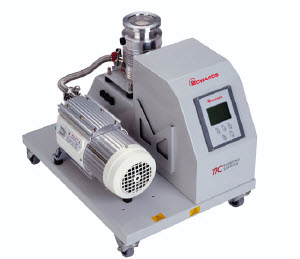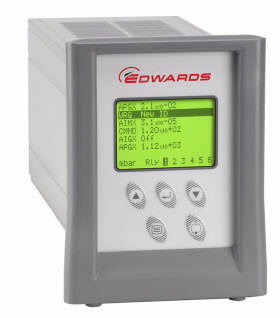![]()
Turbo Pumps UHV Technology
EXT Turbomolecular Pumps & Turbo Systems



Edwards turbomolecular pumps (TMP) is a
multi-stage axial-flow turbine inwhich high speed rotating blades provide
compression by increasing the probability of gas molecules moving in the
pumping direction. Theturbomolecular pump is optimized for
molecular flow conditions and requires a suitably sized two stage rotary
vane pump or an oil free scroll pump to exhaust to atmosphere.
A compound molecular pump (CMP) is based on the concept of combining bladed turbomolecular stages with molecular drag stages on the same rotor. This design allows: High critical foreline pressures (typically up to 10 mbar)
Options to use smaller backing pumps or dry diaphragm backing pumps
Pumping speed (volume flow rate) is determined by the rotor diameter, inlet flange size and rotational speed. The pumping speed reduces at high inlet pressures to a value determined by the size of the backingpump.
As the inlet pressure rises, the motor power dissipation and pump temperature increase. Maximum continuous inlet pressure sets the maximum throughput limit for steady state pumping and depends on the cooling method used. Above this pressure, the rotational speed of the pump reduces as temperature sensors limit the pump power. With a water-cooled pump, the actual maximum throughput depends on the size of the backing pump.
Quiescent electrical power is the nominal power dissipated by a pump operating normally at full rotational speed and with low gas throughput (inlet pressure below the 103 mbar range). During the run-up time, or when operating at high gas throughput or above the critical backing pressure, the pump power dissipation will rise and approach the maximum power output for the EXC Controller used. Critical backing pressure for conventional turbomolecular pumps is approximately 0.1 to 0.2 mbar.
Compression ratio is determined by the rotational speed, the number of pump stages and the molecular weight of the pumped gas. It is higher for heavier gases which explains why the suppression of hydrocarbon backstreaming is so effective and why the ratio for hydrogen is important for ultra high vacuum applications.
Ultimate pressure measured according to Pneurop standards, is the lowest pressure achieved in the test system, 48 hours after bakeout. The system is backed only by a two-stage rotary vane pump.
Fluoroelastomer inlet seals are used with ISO-flanged pumps and metal seals are used with CF-flanged pump models.
Bearing and suspension technologies
We use two basic technologies: magnetic bearings and mechanical ceramic ball bearings. Ceramic bearings, which are lubricated for life by either grease or oil, have replaced conventional steel bearings. The silicon nitride ceramic balls are lighter, harder and smoother than steel equivalents, leading to longer life and lower vibration characteristics. Reliability is increased because the ball and race materials are different, which prevents micro
pitting.
Magnetic bearings further increase reliability. Our EXT turbomolecular pumps up to 540 l s-1 use a hybrid bearing arrangement with a permanent magnet upper bearing and an oil lubricated ceramic lower bearing.
Rotor technologies
Edwards use two basic technologies:
conventional full stack turbomolecular (typically 12 stages) compound molecular (combining turbomolecular and drag stages) In addition, EXT pumps up to 540 l s-1 use monobloc rotors machined from solid bar by computer controlled high speed milling machines. This technology produces stable, rigid rotors and allows virtually unlimited design flexibility for optimum vacuum performance.
Motor technology
EXT pumps use brushless d.c. motors and are available in 24 and 80 volt variants. For the 24 volt pumps the TIC line of controllers are available with the added benefit of integrated instrument controllers. For the 80 volt pumps you can choose from our EXC line of controllers to optimize the performance and cost options for your application.
The Controllers incorporate a regenerative back-up supply which provides power in the event of electrical supply failure to keep the ventvalveclosed for several minutes.
Corrosive applications
For maximum life and reliability in the exacting process conditions encountered in semiconductor wafer processing applications, we recommend that you use turbomolecular pumps from our Edwards STP-C and STPH-C series (see page 2-33). These Maglev pumps have magnetic bearings and are ideal for these harsh duty applications.
For advice on prices or technical support then please call our office or send an email to:- enquiries@premierpumps.com.au
A compound molecular pump (CMP) is based on the concept of combining bladed turbomolecular stages with molecular drag stages on the same rotor. This design allows: High critical foreline pressures (typically up to 10 mbar)
Options to use smaller backing pumps or dry diaphragm backing pumps
Pumping speed (volume flow rate) is determined by the rotor diameter, inlet flange size and rotational speed. The pumping speed reduces at high inlet pressures to a value determined by the size of the backingpump.
As the inlet pressure rises, the motor power dissipation and pump temperature increase. Maximum continuous inlet pressure sets the maximum throughput limit for steady state pumping and depends on the cooling method used. Above this pressure, the rotational speed of the pump reduces as temperature sensors limit the pump power. With a water-cooled pump, the actual maximum throughput depends on the size of the backing pump.
Quiescent electrical power is the nominal power dissipated by a pump operating normally at full rotational speed and with low gas throughput (inlet pressure below the 103 mbar range). During the run-up time, or when operating at high gas throughput or above the critical backing pressure, the pump power dissipation will rise and approach the maximum power output for the EXC Controller used. Critical backing pressure for conventional turbomolecular pumps is approximately 0.1 to 0.2 mbar.
Compression ratio is determined by the rotational speed, the number of pump stages and the molecular weight of the pumped gas. It is higher for heavier gases which explains why the suppression of hydrocarbon backstreaming is so effective and why the ratio for hydrogen is important for ultra high vacuum applications.
Ultimate pressure measured according to Pneurop standards, is the lowest pressure achieved in the test system, 48 hours after bakeout. The system is backed only by a two-stage rotary vane pump.
Fluoroelastomer inlet seals are used with ISO-flanged pumps and metal seals are used with CF-flanged pump models.
Bearing and suspension technologies
We use two basic technologies: magnetic bearings and mechanical ceramic ball bearings. Ceramic bearings, which are lubricated for life by either grease or oil, have replaced conventional steel bearings. The silicon nitride ceramic balls are lighter, harder and smoother than steel equivalents, leading to longer life and lower vibration characteristics. Reliability is increased because the ball and race materials are different, which prevents micro
pitting.
Magnetic bearings further increase reliability. Our EXT turbomolecular pumps up to 540 l s-1 use a hybrid bearing arrangement with a permanent magnet upper bearing and an oil lubricated ceramic lower bearing.
Rotor technologies
Edwards use two basic technologies:
conventional full stack turbomolecular (typically 12 stages) compound molecular (combining turbomolecular and drag stages) In addition, EXT pumps up to 540 l s-1 use monobloc rotors machined from solid bar by computer controlled high speed milling machines. This technology produces stable, rigid rotors and allows virtually unlimited design flexibility for optimum vacuum performance.
Motor technology
EXT pumps use brushless d.c. motors and are available in 24 and 80 volt variants. For the 24 volt pumps the TIC line of controllers are available with the added benefit of integrated instrument controllers. For the 80 volt pumps you can choose from our EXC line of controllers to optimize the performance and cost options for your application.
The Controllers incorporate a regenerative back-up supply which provides power in the event of electrical supply failure to keep the ventvalveclosed for several minutes.
Corrosive applications
For maximum life and reliability in the exacting process conditions encountered in semiconductor wafer processing applications, we recommend that you use turbomolecular pumps from our Edwards STP-C and STPH-C series (see page 2-33). These Maglev pumps have magnetic bearings and are ideal for these harsh duty applications.
For advice on prices or technical support then please call our office or send an email to:- enquiries@premierpumps.com.au